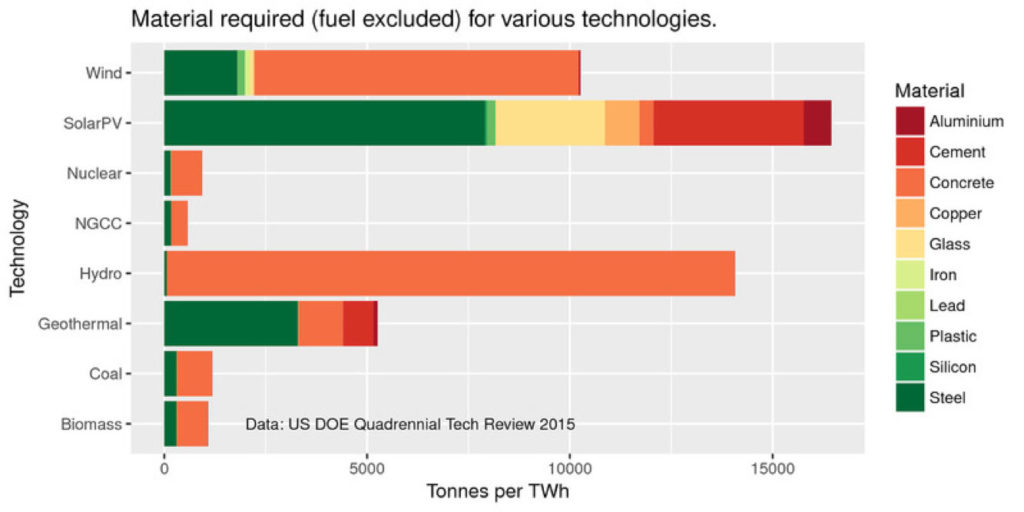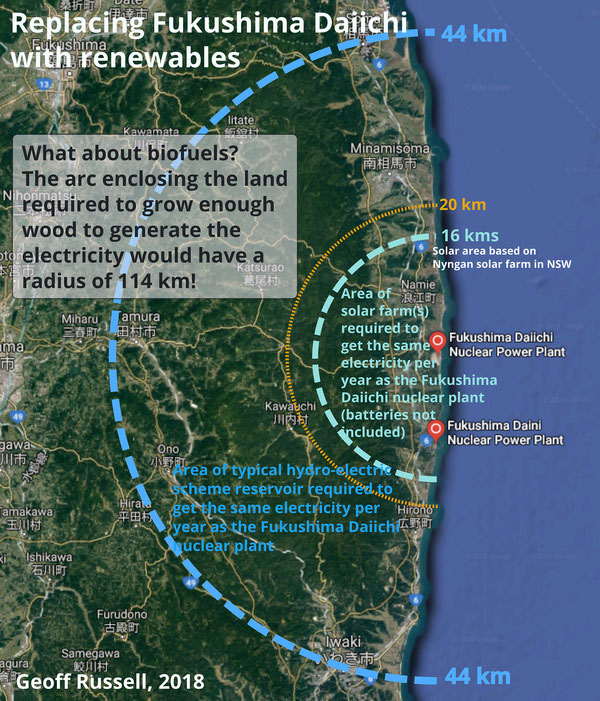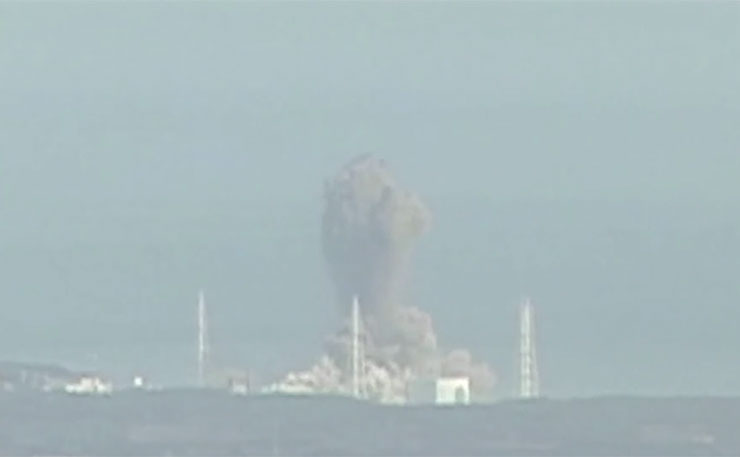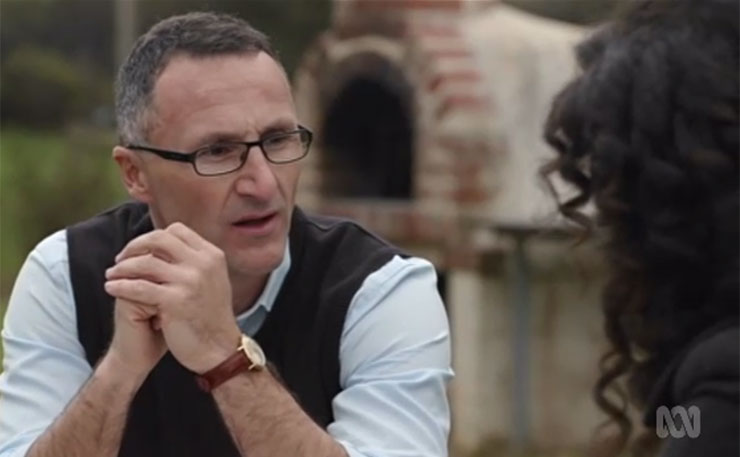Geoff Russell brings you the final story in a three-part series on the global renewable energy revolution. In Part I he looked at the animal and environment issues associated with the flooded river valleys and burning biomass that dominate renewable energy. Part II looked at wind, sunshine, storage and zoomed in to consider Australia.
The alternative
Globally, nuclear power, in case you were wondering, generates just over 2,000 terawatt-hours of electricity annually, about 8 times more than solar and more than double wind power.
Now let’s run some basic numbers and compare the ecological impact of renewables with that of nuclear power.
First let’s deal with the inevitable cry from people who are anti-nuclear without ever having thought much about it: “Nuclear isn’t clean, think about the mining and the waste!!!”.
Mines? Nuclear power is miserly on mines. The amount of mining required for hydro, solar or wind is many times greater. The recent ACOLA report made this point, let me repeat the relevant graph from a previous article.

As you can see, nuclear requires minimal mining.
So why do so many people seem to think mining is some kind of nuclear achilles heel? That’s an interesting question. I’ll try to answer it later. But the graph massively underestimates the mining required for renewables on two fronts; it ignores mining for batteries and it ignores mining for all the extra transmission lines needed by wind and solar. I’ve dealt with the relative ease of nuclear waste handling many times in the past … most recently here.
But mining is a minor issue compared to the massive habitat destruction associated with renewables.
Hydro-electricity, as we’ve seen produces roughly 4,000 terawatt hours per year globally from reservoirs covering 343,000 square kilometres, so, using global averages, you need to flood about 82 square kilometres per annual terawatt-hour. Let’s compare that with the land used by nuclear power. The power station itself uses very little land, but what about the mines?
The Ranger Uranium mine is about 16 square kilometres of open cut mine (including the tailings dam) producing enough uranium on average each year during the past decade to generate 148 terawatt hours of electricity per year. To get that using hydro electricity, you’d need to flood, on average, about (148×82) 12,136 square kilometres.
And what about generating 148 terawatt hours with wood? Vaclav Smil is an expert’s expert on energy. He estimates that using wood to power a 1 gigawatt electric power plant with a 70 percent capacity factor requires about 3,300 square kilometres of fast growing tree plantations. That works out at about 538 square kilometres per annual terawatt-hour. Which means that matching the output of the 16 square kilometre Ranger mine, you’d need to be harvesting 79,647 square kilometres of tree plantations; and considerably more if you were harvesting non-plantation forests.
How much uranium do you need to power a 1 gigawatt reactor for a year? With current reactors, about 200 tonnes. With those of the future? About 2 tonnes.
We can summarise the relative land use impacts of nuclear and renewables in one simple image. When the Fukushima Daiichi reactors failed in 2011 the Japanese effectively lost 4.7 gigawatts of power from their grid. Should the Japanese rebuild with new reactors on or near the site? New reactors of the same power but modern reliability could deliver about 37 terawatt-hours of electricity annually. So how much land would renewables need to generate 37 terawatt-hours annually?
The following figure tells the story. If you wanted to use solar, then you’d need to level most of the 20 km “evacuation” zone to install panels. I’ve seriously underestimated the land required by assuming Japan had Australian levels of sunshine!
If you used hydro power, you’d be flooding a semicircle with a radius of 44 kms.
And what if you did what Germany and the UK are doing, and just started burning forests? Then the semicircle would have a radius of 114 kms.
Here’s a summary map. You can imagine the size of the biggest possible uranium mine (open cut) required to supply uranium to a plant like this. It’s about a square with sides of 2km.

Remember when the environment movement was about protecting forests and rivers? Remember when they cared about maximising habitat for wildlife? Not anymore.
The obvious alternative to hydro and biomass electricity is nuclear, but globally and locally the Green movement is either anti-science or counts far too many in that group among its voting base. Either way it bases its rejection of nuclear power on science formulated in the DNA dark ages; meaning well before the most basic of information on radiation, DNA and cancer was understood.
At the dawn of the anti-nuclear movement, nobody knew anything about the daily churn of normal DNA damage and repair; they didn’t even know that repair of DNA damage was possible; let alone an essential part of staying alive.
The best scientists back in the 1950s and 60s thought DNA damage was an incredibly rare chance event which was permanent and cumulative. But those who study such things now know that both damage and repair are ongoing during every second of your life; due to the entirely normal processes of energy metabolism, simply staying alive.
Let’s suppose you wanted to raise background radiation levels to the kinds of levels that would cause the level of serious DNA damage caused by normal energy metabolism. What do I mean by serious? Breaks across both strands of DNA. Those kinds of breaks are tough to fix and may go on to cause cancer. You get about 50 of these in every cell every day.
How much would you need to increase background radiation to cause this level of double strand breaks? About 219,000 times.

When Japanese Prime Minister Nato Kan ordered the evacuation of Fukushima, he was acting contrary to the best expert opinion, based on 30 years of science, as specified in the IAEA guidelines.
The result of Nato Kan’s fear, ignorance and defiance of the best available science, was cruel and deadly. Sick, frail and elderly people died after being shunted onto busses in the middle of the night in a crazy and totally unnecessary panic spawned by decades of anti-nuclear propaganda; some younger people committed suicide. One radiation expert called the Japanese handling of the Fukushima accident “stark staring mad”; which it was. And continues to be.
No radiotherapist, geneticist, oncologist or DNA biologist trained in the past 40 years believes the assumptions that were used back in 1959 by Linus Pauling to predict cancer and birth defects from weapons test radioactive fallout… except the anti-nuclear movement which those predictions spawned.
Look at any textbook on DNA or cell biology and you’ll find a chapter or two or three on DNA repair. There are whole textbooks on DNA repair. The IAEA guidelines didn’t spring out of the imagination of the nuclear industry, but from bog-standard science. But it’s only bog-standard science if you are paying attention and not stuck in the oral tradition of Green policy which involves passing down mantras about radiation that go back to the 1950s.
Environmentalist George Monbiot called the movement out for its misleading claims about radiation back in 2011, during the Fukushima meltdowns. He began what was a devastating critique of Helen Caldicott as follows:
Over the past fortnight I’ve made a deeply troubling discovery. The anti-nuclear movement to which I once belonged has misled the world about the impacts of radiation on human health. The claims we have made are ungrounded in science, unsupportable when challenged and wildly wrong.
When he questioned Helen Caldicott over her many failed disaster predictions, she retreated to a grand conspiracy theory about a cover up by the United Nations.
The avocado factor
The transformation in understanding of radiation, DNA and cancer, hasn’t just been about DNA repair and the ability to withstand damage from things like radiation and intrinsic normal biological processes, but in two other crucial factors: 1) many things we eat and drink damage DNA in far more serious ways than normal, or even elevated, radiation levels, and 2) damaging DNA is precisely how some things protect us from cancer.
Every piece of protein you eat will slice and dice your DNA; red and processed meat damage DNA and that damage may proceed to cancer, depending on the dose and the quality of your DNA repair mechanisms and chance. The level of detailed knowledge on such matters is extensive but still growing.
But some quite recent discoveries have thrown light on the mechanism behind the cancer protective properties of fruit and vegetables. It’s been generally assumed that this was by antioxidants preventing DNA damage. But then along came avocados. Avocodo plants produce a fungicide called persin. Persin is in the seeds and leeches into the body of the fruit. It damages DNA. Damaging DNA is so common in foods that it isn’t proof of harmfulness, but it was disturbing when discovered in something thought to be as healthy as avocado.
The final discovery that restored confidence in avocado as a health food is that it works like radiotherapy. Radiotherapy works by preferentially damaging the DNA in cancerous cells compared to normal cells. Ditto avocado.
Radiation at normal doses does trivial amounts of damage compared to breathing, exercising and even thinking. To get it to kill cancer cells you need massive doses. To kill cancer cells, radiotherapists give doses at rates millions of times greater than background.
Think about a tumour, a lump in your lung, for example. Radiotherapy for this lump will pass through, and damage, normal tissue. But the reason you need multiple doses during treatment is that even at levels millions of times greater than normal background rates, radiation still doesn’t reliably kill cancer cells. It kills them at higher rates than normal cells, but both can recover. So you give the normal cells, exposed as the radiation passes though your healthy tissue on its way to the tumour, some time to recover and repeat the process.
The feature shared by both radiation and avocado’s persin toxin is that it kills cancer cells preferentially.
There are risks during radiotherapy that those healthy cells exposed to millions of times normal radiation rates won’t repair perfectly and will go on to cause a secondary cancer. But those risks are small.
All of the above is just basic science. You can find it in oncology text books and peer-reviewed research in any good medical journal. But all of it contradicts the basic beliefs of the anti-nuclear movement, because they are stuck in the 1950s.
In conclusion
Starting some time before Monbiot’s devastating critique, many environmental scientists had already rejected the fear-mongering and were shifting toward nuclear as simply the cleanest, greenest, safest energy on the planet, including some of the world’s leading climate scientists. Many, like me, had gone back to the basic science and found, like Monbiot, that the anti-nuclear position was built on, at best, misinformation and obsolete science.
What do you say of people that simply refuse to read any kind of information which may challenge their radiation slogans? Technically it isn’t lying if you believe it, but deliberate ignorance is arguably worse; particularly when it threatens so many horrid consequences.
The Green movement has been incredibly effective in using misinformation to make people frightened of nuclear power. Which has been an absolute godsend for those who love building dams, pelletising forests, fracking gas and, yes, even digging coal.
The climate needs fixing and wildlife habitat needs protecting. The latter has been shrinking for decades as wildlife is replaced by more and more animals for those who eat them. The global environment movement doesn’t get that either.

Australia has a cattle breeder as the leader of our Greens; we may as well have a coal magnate. Habitat and wildlife now has a new enemy, renewable energy. It isn’t as dangerous as the old enemy, “livestock” for meat eaters, but when your range has already been slashed, even small appropriations can have major impacts.
The consequences of basing policy on slogans and populist ignorance rather than evidence are dire for the planet. It’s time for the global Green movement to move to rational evidenced-based policies. Many luddite supporters may abandon it in the short term, but it has to lead and transform it’s support base rather than pander to dangerous ignorant populist bullshit.
In Australia we have a medical doctor leading the Greens. Not all doctors have a quantitative understanding of radiation, radiotherapy and DNA repair mechanisms. There’s also a difference between the quantitative skills of some GPs and most medical researchers.
Nevertheless, Green’s leader Richard Di Natale should be able to read the scientific literature and understand the implications. Perhaps he’s just too frightened to challenge the anti-nuclear, anti-science luddites in the party; just as Turnbull is too scared to tackle the climate change nutters in the Liberal Party.
We desperately need a strong global evidence-based environmental movement, given that both politics-as-usual and the Trump/Brexit alternative are both just minor variations on poll-based populism.
Donate To New Matilda
New Matilda is a small, independent media outlet. We survive through reader contributions, and never losing a lawsuit. If you got something from this article, giving something back helps us to continue speaking truth to power. Every little bit counts.




